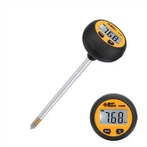Which probe of the pointer multimeter should be connected to the positive pole when measuring the DC voltage?
When using a pointer multimeter to measure DC voltage, you should first check the condition of the multimeter, including whether it measures accurately and whether the pointer is sensitive. Insert the red probe into the jack marked "+ V/Ω" and the black probe into the "- COM" jack. Turn the range selector knob to any position in the resistance range. Short - circuit the red and black probes. The pointer should deflect to the right towards the zero position. Then, rotate the zero - adjustment knob to set the pointer exactly at zero. If the pointer stays at the infinite position and does not swing to the right when the probes are short - circuited, check if the fuse inside the multimeter is blown. If the fuse is normal, replace the battery inside the multimeter. Also, if the pointer cannot be adjusted to zero when the probes are short - circuited in the resistance range, replace the battery.
When measuring DC voltage, if the voltage value is known, you can directly turn the knob to the corresponding DCV range. It's worth noting that the closer the selected range is to the measured voltage, the more accurate the measured value will be. For example, select the 2.5V range for a 1.5V voltage, and the 50V range for 12V or 24V voltages. If the voltage to be measured is unknown, start with the highest range, measure successively and then reduce the range until the selected range is close to the measured voltage. Never measure a high voltage with a low - range setting, as this may cause the pointer to deflect excessively and damage the multimeter. When measuring, place the multimeter as horizontally as possible to avoid affecting the accuracy of the measured value.
When reading the value, look at the second scale line on the meter head marked "ACV.DCV". Count the scale line from left to right. The final value is obtained by multiplying the actual scale reading by the range value and then dividing by the difference of the total scale lines. For example, as shown in the figure above, 47×(10÷50) = 9.4V. This is a newly - bought battery, and the measured value is slightly higher than the marked value, indicating that the battery has excellent performance!






